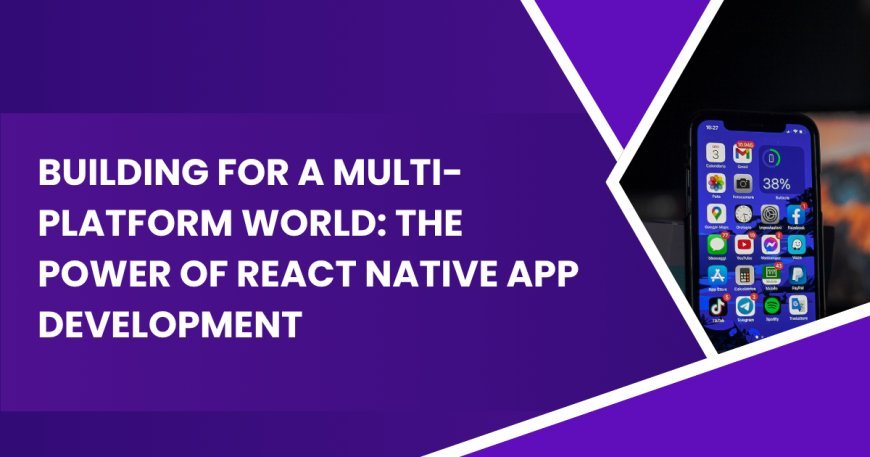Building for a Multi-Platform World: The Power of React Native App Development

In today's mobile-first landscape, having a presence on both iOS and Android is not just an option it's a necessity. Businesses are under immense pressure to deliver a seamless, high-quality user experience across all devices, but the traditional approach of building separate native applications for each platform is a time-consuming, resource-intensive, and often costly endeavor. This is where React Native emerges as a game-changer, offering a compelling alternative that is reshaping the way companies approach mobile app development.
React Native is an open-source framework developed by Meta (formerly Facebook) that allows developers to build natively rendered mobile applications for iOS and Android using a single codebase. At its core, React Native harnesses the power of JavaScript, a language familiar to millions of web developers, and extends its capabilities to create truly native-like mobile experiences. This isn't just about building "hybrid" apps that run inside a web browser; React Native actually compiles JavaScript into native platform UI components, resulting in applications that look, feel, and perform just like their fully native counterparts.
This framework has moved beyond its initial hype to become a mature, stable, and highly sought-after solution for a wide range of businesses, from agile startups to global enterprises. Apps like Instagram, Facebook Ads Manager, and even Microsoft's Skype and Teams, are built on React Native, a testament to its reliability and scalability. For any business looking to launch a mobile app efficiently and effectively, understanding the benefits and nuances of React Native app development is no longer optional it's a strategic imperative.
The Undeniable Advantages of React Native
The decision to choose a development framework is a critical one, with long-term implications for a product's success. Here’s a closer look at the key advantages that make React Native a top choice for modern app development:
-
One Codebase, Two Platforms: This is the most significant benefit of React Native. Instead of writing two separate codebases one in Swift/Objective-C for iOS and another in Java/Kotlin for Android developers can write a single codebase in JavaScript that works for both platforms. This code reusability translates directly into substantial savings in time, money, and resources. Businesses can get to market faster, and maintenance becomes simpler and more streamlined.
-
Faster Development Cycles: React Native’s "hot reloading" and "live reloading" features are a developer's dream. Hot reloading allows developers to see the changes they make to the code instantly on a device or emulator without needing to recompile the entire app. This rapid feedback loop dramatically accelerates the development process, making it possible to build and iterate on features at a blistering pace.
-
Lower Development and Maintenance Costs: By eliminating the need for two separate development teams and two distinct codebases, React Native significantly reduces the overall cost of app development. The cost-effectiveness extends beyond the initial build; maintenance and bug fixes also become more efficient, as developers can address issues on both platforms with a single code change.
-
Native-Like Performance and User Experience: While some might assume a cross-platform framework compromises on performance, React Native defies this expectation. By using a "bridge" to communicate with native APIs and render components natively, React Native apps deliver a smooth and responsive user experience. The resulting applications don't feel like a website packaged as an app; they feel and function like a true native application, which is crucial for user engagement and retention.
-
Strong Community Support and a Rich Ecosystem: As an open-source framework backed by Meta, React Native boasts a massive and vibrant community of developers. This means there is a wealth of readily available components, libraries, and tools that can be leveraged to add complex features quickly and easily. The extensive community also provides a strong support network, with forums and documentation to help developers solve problems and stay up-to-date with the latest trends.
-
Simplified Hiring: The demand for mobile app developers is high, but the pool of JavaScript developers is even larger. By opting for React Native, businesses can tap into this vast talent pool, making it easier and often more affordable to find skilled developers. This also allows web development teams with ReactJS experience to transition to mobile app development with a much lower learning curve.
The React Native Development Process: A Strategic Approach
Building a successful React Native app is a structured process that combines strategic planning with technical execution. A typical development lifecycle includes:
-
Discovery and Planning: This initial phase involves a deep dive into the business goals, target audience, and key features of the app. It's crucial to define the app's core purpose, create user personas, and map out the user journey. This phase culminates in a clear project roadmap, outlining the features, timelines, and technical requirements.
-
UI/UX Design: A great app starts with a great design. Designers create wireframes and mockups, ensuring the app's interface is intuitive, visually appealing, and aligned with the brand's identity. React Native's component-based architecture allows for a seamless translation of these designs into code, as developers can create reusable UI components that maintain a consistent look and feel across the app.
-
Development and Coding: This is the core of the process, where developers write the code using JavaScript and React Native's component library. They leverage third-party libraries for features like push notifications, payment gateways, and geolocation. The focus here is on writing clean, modular, and maintainable code that is both performant and scalable.
-
Quality Assurance and Testing: Rigorous testing is non-negotiable. QA engineers perform a series of tests—including unit tests, integration tests, and UI/UX tests—to identify and fix bugs. The goal is to ensure the app is stable, secure, and performs flawlessly on both iOS and Android devices.
-
Deployment and Launch: Once the app is thoroughly tested and finalized, it's time to prepare it for submission to the Apple App Store and Google Play Store. This process involves generating app bundles, writing a compelling app description, and ensuring all platform-specific guidelines are met.
-
Post-Launch Support and Maintenance: The journey doesn't end with the launch. A successful app requires ongoing support, maintenance, and regular updates to fix bugs, add new features, and adapt to evolving user needs and platform requirements.
React Native vs. Native Development: A Nuanced Comparison
While React Native offers significant advantages, it's important to have a balanced perspective. For certain highly specialized applications, such as those requiring intensive graphics, complex animations, or direct access to very specific hardware features, a fully native approach might still be the superior choice. Native development, using platform-specific languages like Swift and Kotlin, provides unparalleled performance and direct access to all device APIs without any "bridge" overhead.
However, for the vast majority of mobile applications from e-commerce platforms and social networking tools to enterprise solutions and media apps React Native provides an optimal blend of efficiency, performance, and cost-effectiveness. It allows businesses to reach a wider audience more quickly, all while delivering a user experience that rivals that of native apps.
In conclusion, React Native app development has emerged as a powerful and strategic choice for businesses aiming to conquer the multi-platform mobile market. Its ability to use a single codebase to create high-performance, native-like applications for both iOS and Android is a major competitive advantage. By embracing this framework, businesses can unlock new levels of efficiency, reduce costs, and accelerate their time to market, all while providing their users with a seamless and compelling mobile experience.
What's Your Reaction?

































































